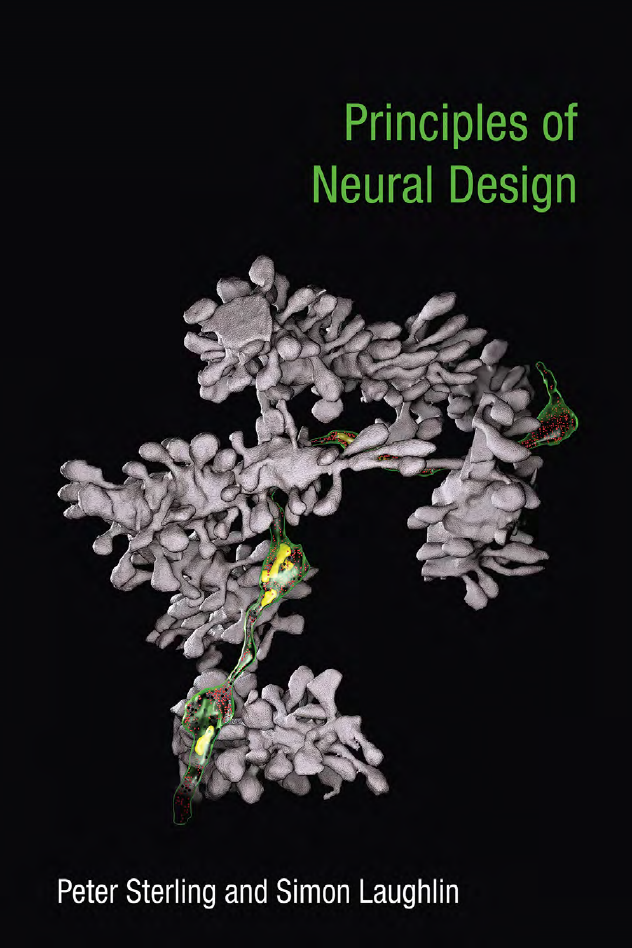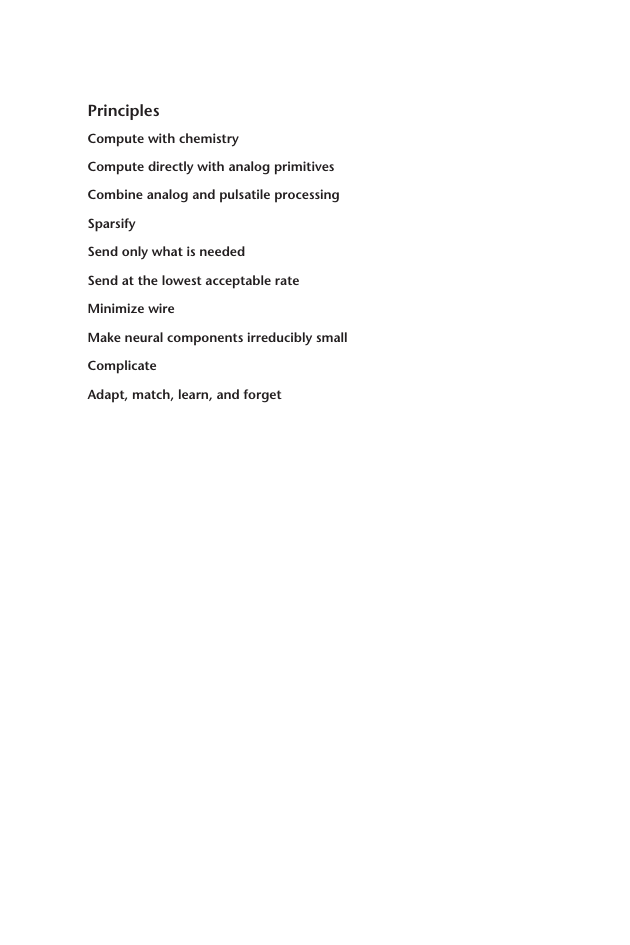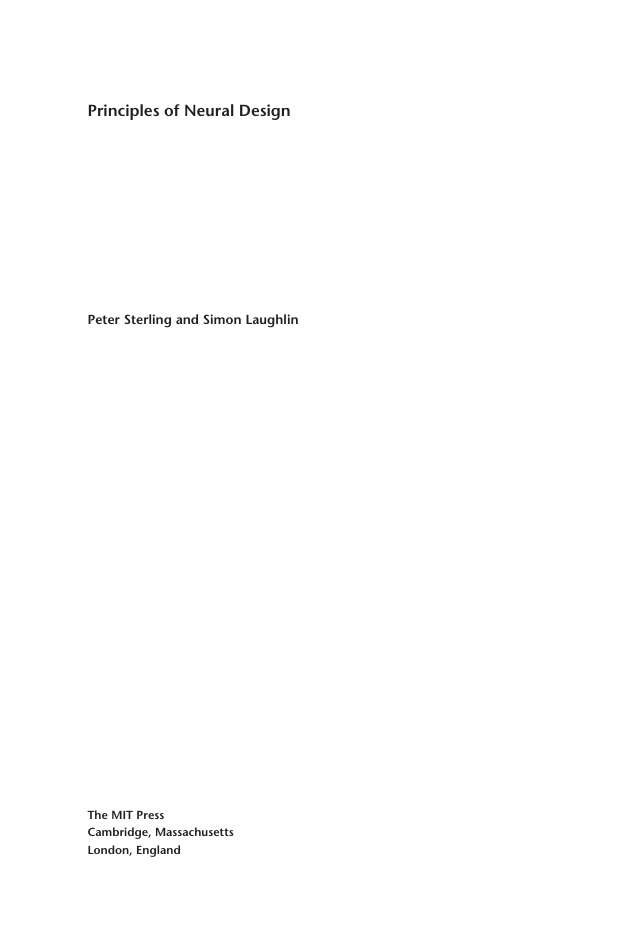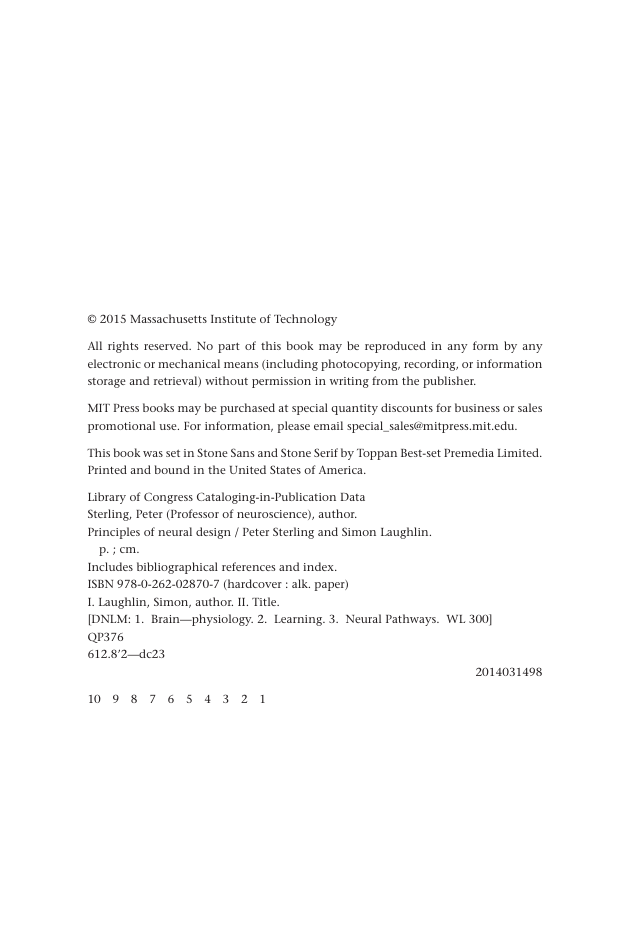�
Principles of Neural Design
Principles
Compute with chemistry
Compute directly with analog primitives
Combine analog and pulsatile processing
Sparsify
Send only what is needed
Send at the lowest acceptable rate
Minimize wire
Make neural components irreducibly small
Complicate
Adapt, match, learn, and forget
�
Principles of Neural Design
Peter Sterling and Simon Laughlin
The MIT Press
Cambridge, Massachusetts
London, England
�
© 2015 Massachusetts Institute of Technology
All rights reserved. No part of this book may be reproduced in any form by any
electronic or mechanical means (including photocopying, recording, or information
storage and retrieval) without permission in writing from the publisher.
MIT Press books may be purchased at special quantity discounts for business or sales
promotional use. For information, please email special_sales@mitpress.mit.edu.
This book was set in Stone Sans and Stone Serif by Toppan Best-set Premedia Limited.
Printed and bound in the United States of America.
Library of Congress Cataloging-in-Publication Data
Sterling, Peter (Professor of neuroscience), author.
Principles of neural design / Peter Sterling and Simon Laughlin.
Includes bibliographical references and index.
ISBN 978-0-262-02870-7 (hardcover : alk. paper)
I. Laughlin, Simon, author. II. Title.
[DNLM: 1. Brain — physiology. 2. Learning. 3. Neural Pathways. WL 300]
QP376
612.8’2 — dc23
p. ; cm.
10
9
8
7
6
5
4
3
2
1
2014031498
�
For Sally Zigmond and Barbara Laughlin
�
�
Contents
ix
Preface
Acknowledgments
xiii
Introduction
xi
1
2
3
4
5
6
7
8
9
What Engineers Know about Design
1
Why an Animal Needs a Brain
11
Why a Bigger Brain?
41
How Bigger Brains Are Organized
57
Information Processing: From Molecules to Molecular Circuits
105
Information Processing in Protein Circuits
125
Design of Neurons
155
How Photoreceptors Optimize the Capture of Visual Information
195
The Fly Lamina: An Efficient Interface for High-Speed Vision
235
10
Design of Neural Circuits: Recoding Analogue Signals to Pulsatile
265
11
Principles of Retinal Design
277
12
Beyond the Retina: Pathways to Perception and Action
323
13
Principles of Efficient Wiring
363
14
Learning as Design/Design of Learning
399
15
Summary and Conclusions
433
445
447
Principles of Neural Design
Notes
References
Index
519
465
�
















 2023年江西萍乡中考道德与法治真题及答案.doc
2023年江西萍乡中考道德与法治真题及答案.doc 2012年重庆南川中考生物真题及答案.doc
2012年重庆南川中考生物真题及答案.doc 2013年江西师范大学地理学综合及文艺理论基础考研真题.doc
2013年江西师范大学地理学综合及文艺理论基础考研真题.doc 2020年四川甘孜小升初语文真题及答案I卷.doc
2020年四川甘孜小升初语文真题及答案I卷.doc 2020年注册岩土工程师专业基础考试真题及答案.doc
2020年注册岩土工程师专业基础考试真题及答案.doc 2023-2024学年福建省厦门市九年级上学期数学月考试题及答案.doc
2023-2024学年福建省厦门市九年级上学期数学月考试题及答案.doc 2021-2022学年辽宁省沈阳市大东区九年级上学期语文期末试题及答案.doc
2021-2022学年辽宁省沈阳市大东区九年级上学期语文期末试题及答案.doc 2022-2023学年北京东城区初三第一学期物理期末试卷及答案.doc
2022-2023学年北京东城区初三第一学期物理期末试卷及答案.doc 2018上半年江西教师资格初中地理学科知识与教学能力真题及答案.doc
2018上半年江西教师资格初中地理学科知识与教学能力真题及答案.doc 2012年河北国家公务员申论考试真题及答案-省级.doc
2012年河北国家公务员申论考试真题及答案-省级.doc 2020-2021学年江苏省扬州市江都区邵樊片九年级上学期数学第一次质量检测试题及答案.doc
2020-2021学年江苏省扬州市江都区邵樊片九年级上学期数学第一次质量检测试题及答案.doc 2022下半年黑龙江教师资格证中学综合素质真题及答案.doc
2022下半年黑龙江教师资格证中学综合素质真题及答案.doc